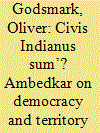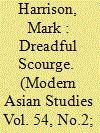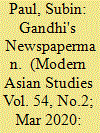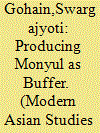|
|
|
Sort Order |
|
|
|
Items / Page
|
|
|
|
|
|
|
| Srl | Item |
| 1 |
ID:
172006


|
|
|
|
|
| Summary/Abstract |
This article considers Ambedkar's ideas about the implementation of democracy in India, in the context of the linguistic reorganization of provincial administrative boundaries. In doing so, it looks to emphasize the importance of territorial configurations to Dalit politics during this period and, in particular, the consequences of ‘provincialization’, which has received little attention within the existing literature. Rethinking space by redrawing administrative territory provided Ambedkar with one potential avenue through which to escape the strictures of Dalits’ minority status. In this vision, linguistic reorganization (and partition) were harbingers of greater democratization and potential palliatives to the threat of Hindu majority rule at the centre. In turn, however, Ambedkar simultaneously came to perceive the creation of these new administrative spaces as marking a new form of provincial majoritarianism, despite his best efforts to form alliances with those making such demands. In this sense, the article also seeks to address some of the shared processes behind linguistic reorganization and partition as two related forms of territorial redrawing. In the face of these demands, and the failures of both commensuration and coalition politics, Ambedkar turned to the idea of separate settlements for Dalits, whereby they might themselves come to constitute a majority. Whilst such a novel attempt at separation and resettlement was not ultimately realized, its emergence within Ambedkar's thought at this time points towards its significance in any history of caste and untouchability in twentieth-century South Asia.
|
|
|
|
|
|
|
|
|
|
|
|
|
|
|
|
| 2 |
ID:
172010


|
|
|
|
|
| Summary/Abstract |
This article focuses on the development of early modern consumerism in a part of the Middle East that historians of consumer culture are yet to fully explore. Making use of a wide variety of unexplored and underexplored original sources, the article contends that early modern consumer culture in Iran was grounded deeply in the ever-widening patterns of exchange and use that had developed slowly over the course of the previous centuries. The discussion below takes the growing popular interest in a few key psychoactive substances as a useful barometer of the dynamics of mass consumption, and chronicles how the slow and ever-expanding use of alcohol, opium, and cannabis (or a cannabis-like product) in the medieval period led to the popularity of coffee, tobacco, older drugs, and still other commodities in the sixteenth and seventeenth centuries. The aim here is to use the history of drug culture as an entry point to scrutinize the emergence of early modern consumerism among the elites and the non-elites in both urban and rural areas of the Middle East. In doing so, this article reconstructs the cultural and social history of recreational drugs prior to and during the early modern period, and elucidates the socio-economic context that helped bring about a ‘psychoactive revolution’ in the Safavid state (1501–1736).
|
|
|
|
|
|
|
|
|
|
|
|
|
|
|
|
| 3 |
ID:
172009


|
|
|
|
|
| Summary/Abstract |
In 1817–21, the Indian subcontinent was ravaged by a series of epidemics which marked the beginning of what has since become known as the First Cholera Pandemic. Despite their far-reaching consequences, these epidemics have received remarkably little attention and have never been considered as historical subjects in their own right. This article examines the epidemics of 1817–21 in greater detail and assesses their significance for the social and political history of the Indian subcontinent. Additionally, it examines the meanings that were attached to the epidemics in the years running up to the first appearance of cholera in the West. In so doing, the article makes comparisons between responses to cholera in India and in other contexts, and tests the applicability of concepts used in the study of epidemics in the West. It is argued that the official reaction to cholera in India was initially ameliorative, in keeping with the East India Company's response to famines and other supposedly natural disasters. However, this view was gradually supplemented and replaced by a view of cholera as a social disease, requiring preventive action. These views were initially rejected in Britain, but found favour after cholera epidemics in 1831–32. Secondly, in contrast to later epidemics, it is argued that those of 1817–21 did little to exacerbate tensions between rulers and the ruled. On the rare occasions when cholera did elicit a violent reaction, it tended to be intra-communal rather than anti-colonial in nature.
|
|
|
|
|
|
|
|
|
|
|
|
|
|
|
|
| 4 |
ID:
172008


|
|
|
|
|
| Summary/Abstract |
The expansion of the colonial public sphere in India during the 1930s and 1940s saw the nation's English-language press increasingly serve as a key site in the struggle for freedom despite British censorship. This article examines the journalistic career of T. G. Narayanan, the first Indian war correspondent and investigative reporter, to understand the role of English-language newspapers in India's quest for independence. Narayanan reported on two major events leading to independence: the Bengal famine of 1943 and the Second World War. Drawing on Michael Walzer's concept of the ‘connected critic’, this research demonstrates that Narayanan's journalism fuelled the Indian nationalist movement by manoeuvring around British censors to publicize and expand Mahatma Gandhi's criticism of British rule, especially in light of the famine and war. His one departure from the pacifist leader, however, was his support of Indian soldiers serving in the Indian National Army and British Army.
|
|
|
|
|
|
|
|
|
|
|
|
|
|
|
|
| 5 |
ID:
172012


|
|
|
|
|
| Summary/Abstract |
This article provides quantitative assessments of the great famines that occurred in Vietnam and Java in 1944–1945, which together claimed the lives of some 3.4 million people. It shows that in both Vietnam and Java, harvest shortfalls, in which weather figured prominently, were so large that insufficient food was available to feed everyone. Nevertheless, in both instances, even with the pressures of war and weather, governments could have acted differently and largely, perhaps even wholly, prevented famine. Although Java's famine had few political repercussions, Vietnam's was instrumental in the August 1945 Viet Minh and communist revolution.
|
|
|
|
|
|
|
|
|
|
|
|
|
|
|
|
| 6 |
ID:
172013


|
|
|
|
|
| Summary/Abstract |
This article focuses on performing artists at the court of Maharaja Ranjit Singh (r. 1801–39), the last fully sovereign ruler of the Punjab and leader of what is termed the Sikh empire. After Ranjit's death, his successors ruled for a mere decade before British annexation in 1849. Ranjit Singh's kingdom has been studied for the extraordinary authority it exercised over warring Sikh factions and for the strong challenge it posed to political rivals like the British. Scholarly exploration of cultural efflorescence at the Lahore court has ignored the role of performing artistes, despite a preponderance of references to them in both Persian chronicles of the Lahore court and in European travelogues of the time. I demonstrate how Ranjit Singh was partial to musicians and dancers as a class, even marrying two Muslim courtesans in the face of stiff Sikh orthodoxy. A particular focus is on Ranjit's corps of ‘Amazons’—female dancers performing martial feats dressed as men—the cynosure of all eyes, especially male European, and their significance in representing the martial glory of the Sikh state. Finally, I evaluate the curious cultural misunderstandings that arose when English ‘dancing’ encountered Indian ‘nautching’, revealing how gender was the primary axis around which Indian and European male statesmen alike expressed their power. Ubiquitous in the daily routine of Ranjit and the lavish entertainments set up for visitors, musicians and female performers lay at the interstices of the Indo-European encounter, and Anglo-Sikh interactions in particular.
|
|
|
|
|
|
|
|
|
|
|
|
|
|
|
|
| 7 |
ID:
172007


|
|
|
|
|
| Summary/Abstract |
This article focuses on the Tawang and West Kameng districts of Arunachal Pradesh, northeast India, collectively known as Monyul. It was ruled by Tibet for three centuries before the 1914 McMahon Line boundary included it in India. Even after that, cross-border exchanges between Monyul and Tibet continued until the 1962 Sino-Indian war, following which border passages between the two were closed. Today, Monyul is a marginal region, geographically distant from centres of industry and education, and lacking in terms of infrastructure. This article traces Monyul's marginality not simply to the border war, but to spatial practices of the British colonial state, beginning with the mapping of the boundary in 1914. It shows how Monyul was constructed as a buffer, despite being within a delimited boundary, first, by excluding it from regular administration, and, secondly, by pushing back the older Tibetan administration, thereby, making it (what I call) a ‘zone of difference/indifference’. But the buffer project was subject to contestation, mostly from the Tibetan religious aristocracy, whose temporal hold over, and material interests in, Monyul were challenged by the latter's incorporation into colonial India.
|
|
|
|
|
|
|
|
|
|
|
|
|
|
|
|
| 8 |
ID:
172005


|
|
|
|
|
| Summary/Abstract |
This article explores the politics of civic engagement during India's long decolonization between 1938 and 1952 for communities—the erstwhile ‘criminal tribes’—whose lifestyles were complicated by controls on their movement before and shortly following India's independence. It argues that their varied and contingent strategies of mobilization increasingly identified community particularities—notably, their marking as ‘criminals’ and a history of movement—as a basis for negotiating their problematic inclusion within the evolving citizenship frameworks of the late colonial, then post-colonial, state. These early forms of civic consciousness set the parameters for later strategies that sought to mobilize communities by engaging with ‘universal’, ‘differentiated’, and indigenized conceptions of civic responsibility and rights. The most surprising finding of this research is that these strategies (via anti-colonialism) often embraced and celebrated forms of illegality and criminality. The romanticism of the dacoit (bandit)-cum-freedom fighter charged Dhaku Sultan-like figures with political heroism. In the context of independence and the founding of the Constitution, strategies turned to the (un)realized promises of freedom and citizenship rights. The final part of the article turns to the implications of ‘denotification’ for the so-called criminal tribes in the early 1950s, which provided both obstacles and avenues to strategies of mobilization after independence.
|
|
|
|
|
|
|
|
|
|
|
|
|
|
|
|
|
|
|
|
|